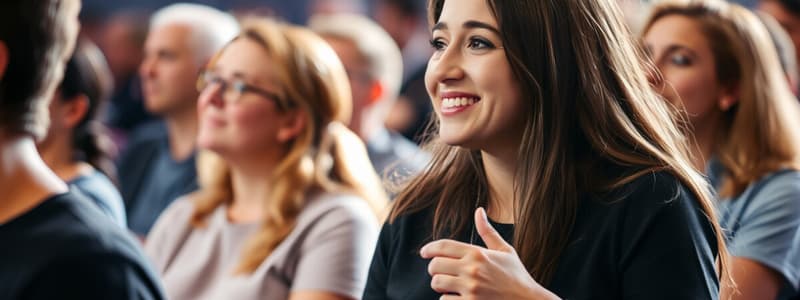Podcast
Questions and Answers
What does the term 'Anchorage' refer to in media studies?
What does the term 'Anchorage' refer to in media studies?
- A method of audience engagement through participation
- The process of editing a film's final cut
- Text that fixes an image and its meaning (correct)
- A technique to capture audience attention
Which of the following best describes 'Active Audience'?
Which of the following best describes 'Active Audience'?
- An audience that passively consumes media content
- Listeners who engage solely with radio broadcasts
- Audiences that interact and create their own meanings (correct)
- Viewers who only watch mainstream media
What does the term 'cross media ownership' refer to?
What does the term 'cross media ownership' refer to?
- Distributing media content across various countries.
- The strategy of collaborating between different media creators.
- A company owning multiple forms of media. (correct)
- When a media company reformulates its own subsidiaries.
What is the role of the Advertising Standards Authority (ASA)?
What is the role of the Advertising Standards Authority (ASA)?
What is the primary purpose of continuity editing?
What is the primary purpose of continuity editing?
In media contexts, what does 'Bias' refer to?
In media contexts, what does 'Bias' refer to?
Which term refers to characters based on original models in fiction?
Which term refers to characters based on original models in fiction?
What does 'demographics' refer to in media studies?
What does 'demographics' refer to in media studies?
What does 'Binary Opposition' signify in narrative structures?
What does 'Binary Opposition' signify in narrative structures?
Which of the following best defines 'convergence' in media?
Which of the following best defines 'convergence' in media?
What is an example of 'Click Bait'?
What is an example of 'Click Bait'?
What does 'cultural hegemony' imply in the context of media?
What does 'cultural hegemony' imply in the context of media?
Which technology is described as combining computer-generated images with the physical environment?
Which technology is described as combining computer-generated images with the physical environment?
What is the significance of 'diegetic sound' in film?
What is the significance of 'diegetic sound' in film?
What role does 'data mining' play in media?
What role does 'data mining' play in media?
What does 'consumption' in media refer to?
What does 'consumption' in media refer to?
Flashcards are hidden until you start studying
Study Notes
Media Theories and Concepts
- Active Audience: Engages with media by contributing, participating, or creating interpretations.
- Agenda Setting: Media shapes public and political focus by determining what issues are considered important.
- Ambiguity: A media product or sign may possess multiple meanings, leading to varied interpretations.
- Anchorage: Textual elements that clarify or fix the meaning of an accompanying image.
- Binary Opposition: The contrast between two opposing concepts, which can create narrative conflict.
- Cultural Hegemony: Dominant cultural beliefs presented as natural, influencing audience perspective.
Media Industry and Regulation
- Advertising Standards Authority (ASA): A self-regulatory body managing advertising standards across various media in the UK.
- BBFC (British Board of Film Classification): Responsible for film classification and censorship, ensuring age-appropriate content distribution.
- Commercial Broadcasting: Privately owned media outlets operate with the intent to profit.
- Concentration of Ownership: Fewer organizations own greater media assets, impacting diversity and competition in media sectors.
- Deregulation: Efforts to lessen government control over media practices to encourage free market competition.
Audience Engagement
- Audience Positioning: Techniques designed to guide audiences toward specific interpretations of media products.
- Citizen Journalists: Non-professionals contributing news and opinions via social media and blogs.
- Diffused Audience: A broad audience that is widely scattered across various platforms.
Media Production Techniques
- Augmented Reality: Technology that overlays computer-generated images onto the real-world environment.
- Camera Movement: Techniques to create depth by moving the camera during filming.
- Continuity Editing: Editing methods that ensure a logical progression between shots.
- Cross-Cut: An editing strategy that depicts multiple simultaneous actions.
- Crane Shot: A high-angle shot captured from a crane, providing a sweeping view.
Visual and Textual Elements
- Avatar: A digital representation or character symbolizing a user's identity in online platforms.
- Big Close Up: A shot emphasizing intricate details of a person or object, often facial features.
- Colour Palette: The selection of colors used to convey brand identity or emotional tone in media.
- Denotation: The literal meaning of a media product or sign, devoid of interpretation.
- Dialogue: The spoken words by characters, advancing the narrative.
Media Forms and Genres
- Blockbuster: High-budget films produced primarily by Hollywood studios aimed at mass audiences.
- CGI (Computer-Generated Imagery): Digital graphics used to create special effects in films.
- Click Bait: Content designed to attract clicks with sensationalized headlines, often misrepresentative.
- Content Provider: Organizations that generate content meant for televised distribution.
Economic and Social Factors
- Austerity: Government strategies focused on minimizing public spending.
- Demographics: Statistical characteristics of a population sample, such as age and gender.
- Data Mining: The process of analyzing raw data to extract meaningful information for various applications.
- Convergence: The integration of technologies and industries to form unique media experiences.
Other Important Terms
- By-line: Credit line indicating the author of an article.
- Censorship: Regulation of media content, aiming to restrict material deemed inappropriate.
- Copy: The textual content within a media piece, often focusing on engaging audiences.
Miscellaneous
- Demonisation: The portrayal of individuals or groups as malevolent or evil.
- Cold Opening: An engaging scene that occurs before the opening credits to capture viewer interest.
- Cut: An editing technique used to switch from one shot to another, altering the narrative flow.
- Cross Media Ownership: A situation where a single company owns multiple types of media, such as television, radio, and newspapers.
Studying That Suits You
Use AI to generate personalized quizzes and flashcards to suit your learning preferences.




